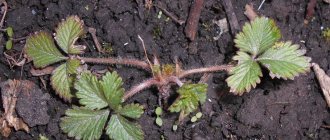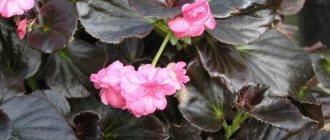Author: Elena N. https://floristics.info/ru/index.php?option=com_contact&view=contact&id=19 Category: Garden plants Published: January 05, 2019Last edits: January 20, 2021
- Growing conditions
- Preparing for winter
- Cinquefoil (Potentilla apennina)
- Beneficial features
plant (lat. Potentilla) is one of the largest genus of the Rosaceae family in terms of the number of species, the most characteristic representatives of which are the cinquefoil goose and the cinquefoil erect, or galangal grass. Most of the species of this numerous genus grow in the Northern Hemisphere. The name of the plant comes from the Latin word potent - which means “strong, powerful” and, apparently, characterizes the strength and power of the healing properties of some plants of this genus, known to mankind since ancient times. Among the cinquefoils, of which there are about five thousand in the world, there are many herbaceous species, but there are also shrubs. Both the cinquefoil grass and the cinquefoil shrub are grown in garden culture. We call cinquefoil bush cinquefoil or Kuril tea, and an ancient legend tells that Ilya Muromets himself inhaled the aroma of cinquefoil to gain unprecedented strength. Since ancient times, decoctions and infusions from the mighty plant, as healers in Rus' called cinquefoil, were used to treat various diseases and to restore strength. Today, cinquefoil is largely an ornamental plant, widely used by landscape designers as a tapeworm on a green lawn, as well as for decorating hedges, borders, and alpine slides.
Planting and caring for cinquefoil
- Planting: sowing seeds in the ground - in autumn or spring, sowing seeds for seedlings - in February or March, transplanting seedlings into the ground - at the end of summer.
- Flowering: from July, about two months.
- Lighting: in the morning - bright light, in the afternoon - partial shade.
- Soil: loose, well-drained, nutritious, slightly acidic and containing some lime.
- Watering: only during drought, once every two weeks. Water consumption - a bucket per bush.
- Pruning: early spring for sanitary purposes.
- Feeding: three times per season with mineral fertilizers for flowering plants: in May, July, August or September.
- Reproduction: by seeds, including self-sowing, and vegetatively - by dividing the bush in April-May or early September, as well as layering and cuttings in July or August.
- Pests: cutworms and their caterpillars.
- Diseases: powdery mildew, rust, spotting.
Read more about growing cinquefoil below.
Fertilizer and feeding
In addition to the mineral fertilizer applied during planting, cinquefoil needs the following feeding:
Potassium sulfate and phosphate fertilizer:
- 25-30 g of both per bucket of water;
- 1 bucket is enough for 1 bush;
- application time is spring.
For abundant flowering, the crop needs regular fertilizing.
Phosphorus and potassium fertilizing:
- use any according to the instructions;
- Application time: before flowering.
Botanical description
The cinquefoil flower is represented by both perennial, biennial and annual herbaceous plants and subshrubs. The stems of representatives of this genus are most often erect, widened or erect, sometimes creeping. The leaves are multipartite or pinnate, green or gray-green in color. Shrub species of cinquefoil reach a height of one and a half meters, growing in width by approximately one meter. The flowers of most species are collected in pseudo-umbellate or corymbose-paniculate inflorescences, but there are species with single flowers. The colors of the flowers are varied - red, golden yellow, orange, pink, cream, white.
Potentilla flower lasts a long time - from May to September. The fruit consists of a large number of achenes - from 10 to 80, usually bare, but sometimes hairy, and the more exotic the type of plant, the larger the fruit.
Description of the plant and features
Shrub cinquefoil (cinquefoil) is also called Dasiphora fruticosa or Kuril tea. These are compact, bushy plants with a low, spreading form. The cinquefoil plant grows up to 1 meter in height and up to 1.5 meters in width.
Garden varieties of shrubby perennial cinquefoil develop oblong silver-green leaves. The uppermost leaves consist of 5 petals; on the lower side the leaf blade is covered with silvery hairs. Sometimes the leaves are trifoliate and are placed on woody shoots.
Cinquefoil shrub - photo of leaves
From late summer to mid-autumn, small flowers develop on the bushes, the color of which varies depending on the variety:
- white,
- yellow,
- shades of pink,
- peach, orange,
- red-orange,
- red.
Planting cinquefoil
All cinquefoils are undemanding to growing conditions, with the exception of a few finicky species, which include, for example, white cinquefoil, which prefers to grow in the shade, or shiny cinquefoil, which feels best in southern exposure on dry sandy soils. All other species love bright areas, shaded in the afternoon by other plants, and loose, slightly acidic, nutritious and well-drained soil containing a small amount of lime. The exception is arctic cinquefoil, which needs acidic soil.
- Mock orange: cultivation, propagation, types and varieties
Potentilla herbaceous from seeds
Potentilla is propagated in different ways, including seeds. Professionals say that you can sow the seeds of herbaceous cinquefoil species simply in the ground in the fall, so that they undergo natural stratification over the winter, after which in the spring the seedlings sprout together, and all that remains is to plant them. You can sow seeds in the ground in spring.
But we suggest not to risk the seed and grow seedlings by sowing the seeds in February or March and germinating them under polyethylene at a temperature of 15-18 ºC. As soon as the seedlings have real leaves, they need to be planted in separate cups or peat pots. Seedlings grow slowly, but, nevertheless, at the end of summer they are planted in open ground in a permanent place. For the winter, young plants must be covered. Potentillas bloom from seeds in the second year.
Cinquefoil often reproduces by self-sowing.
Planting shrubby cinquefoil
In early spring, when the snow melts and the soil thaws, seedlings of shrubby cinquefoil varieties are planted in holes that should be twice as deep and wide as the earthen ball or the size of the container in which the cinquefoil roots are located. The distance between two bushes should be at least 30 cm. A layer of lime gravel is poured onto the bottom of the hole as drainage, then the hole is half filled with a mixture of humus, leaf soil and sand in a ratio of 2:2:1, to which 150 g of complex mineral fertilizer is added . The seedling is lowered into the hole so that its root collar is slightly above the level of the surface of the site, then the hole is filled to the top with garden soil, compacted and watered.
For three weeks after planting, make sure that the cinquefoil bush does not lack water. Mulch the area with straw, bark or sawdust - this will prevent the soil from drying out too quickly. If necessary, planting of cinquefoil is carried out in late summer or early autumn.
Cinquefoil in landscape design
Quite often, landscape designers choose cinquefoil to design compositions. This shrub looks great in a rock garden against the background of a stone fill in the company of conifers, perennials and other deciduous shrubs. Thanks to the variety of varieties of shrubby cinquefoil, you can choose a shrub of the desired size and with flowers of the required shades.
In a mixed foliage composition or even just in a stone fill, cinquefoil looks very decorative thanks to the delicate small leaves of bright green shades and a scattering of bright flowers over the entire surface of the crown.
Beautiful flowering borders of cinquefoil are becoming more and more popular every year. The first leaves on this shrub begin to appear very early and, thanks to excellent winter hardiness, remain on the shoots until frost, preserving the decorative appearance of the landscape throughout the season.
Cinquefoil care
Growing conditions
Growing shrubby cinquefoil, like herbaceous cinquefoil, does not require much effort. Caring for plants consists of weeding, loosening the soil, watering, fertilizing, removing faded flowers and mulching the soil on the site. You will have to water the cinquefoil only during the period of no rain once every two weeks with a bucket of warm water under each bush, and if you mulch the area with peat or sawdust in the spring, you will also have to weed and loosen the soil infrequently. In the summer you will need to add mulch to the area two or three times.
You need to feed cinquefoil with mineral fertilizers for flowering plants three times a season - in May, July and August or September. This is a mandatory program for caring for cinquefoil, but if on sultry summer evenings at the end of a hot day you spray the cinquefoil with water, it will thank you for this with abundant flowering.
Reproduction
In addition to the seed method of propagation, cinquefoils use vegetative methods - dividing the bush, cuttings and layering. Cuttings and propagation by layering are carried out in July-August, and dividing the bush in the spring, in April-May, or in the fall, in early September.
To divide the cinquefoil rhizome, a bush that has reached four years of age is dug up, the rhizome is washed and cut into pieces with a sharp sterile knife, each of which should have 2-3 buds. The roots of the divisions are treated with a root formation stimulator and planted in the ground, trying not to bury the buds. When planting, maintain a distance between divisions of 20-40 cm.
Cuttings 8-10 cm long are cut from the ends of the shoots, removing the flowers. Root the shoots in damp perlite for a month and a half in a frost-free room. You can plant them for rooting simply in the ground somewhere in a shady corner of the garden, covering them with a jar or cut-off plastic bottle, spraying them several times a day. If buds appear, they must be torn off so that flowering does not weaken the rooting cuttings. For the winter, the cuttings are covered with spruce branches.
The easiest way to reproduce is layering. How to propagate cinquefoil by layering? Select a low-growing shoot in the spring, cut it along the outside, place the shoot in the dug groove with the cut down, attach it to the ground in this exact place and cover it with earth. By autumn, the cuttings will have formed a root system and can be separated from the mother plant and transplanted to a permanent place.
Trimming
Growing and caring for shrubby cinquefoil, in addition to the listed procedures, also requires pruning of the plant, which is carried out in early spring, before the buds open, and in the fall. If the cinquefoil is not cut, the plant becomes a shaggy, unkempt bush.
Pruning cinquefoil pursues sanitary purposes, for which broken, dry and inward-growing branches are removed from the bush, and also serves to shape the bush - most often the plant is given the shape of a ball or pillow. In the spring, last year's growths are cut back by a third, and in the fall, shoots that are too elongated and old are removed. Mature plants are subjected to rejuvenating treatment every five years or if a large number of dry twigs appear. To do this, a third of the dry branches on the bush are cut off for three years in a row. As a result, the bush is completely renewed.
- Currant hedge - it turns out simple and beautiful
Pests and diseases
As you can see, planting and caring for cinquefoil is not at all burdensome, and you are unlikely to have to fight diseases or harmful insects, since pests and diseases rarely bother cinquefoil. Sometimes it is affected by rust, spotting or powdery mildew. If the infection occurs with an annual species of cinquefoil, then there is no particular problem - the plant will not lose its decorative properties, and in the fall it must still be disposed of. Perennial varieties and types of cinquefoil need to be treated with a fungicide - Bordeaux mixture or colloidal sulfur, for example.
Among the pests on cinquefoil, cutworms are sometimes found, which are destroyed by treating the plant with insecticides such as Fufanon, Decis Profi, Fitoverm.
Trimming
This is an important stage in caring for perennial plants. Don't underestimate the importance of properly done pruning.
Why is pruning needed?
Pruning allows you to shape the crown of the plant, avoid excessive thickening, and therefore the development of diseases.
First trim
Before 3 years of age, pruning is not recommended: the plant is still too young, and its growth rate is very high.
Upon reaching 3 years, the first pruning is carried out. It will allow you to maintain the attractive shape of the cinquefoil, prevent the “disintegration” of the crown and help prevent unauthorized rooting of layering.
Sanitary pruning
To prevent the development of fungal diseases, regular sanitary pruning is needed. Their goal is to remove from the bush damaged, old, diseased and shoots growing towards the inside of the crown.
Stimulating
To stimulate active lateral branching, and therefore more luxuriant flowering, it is necessary to reduce the length of the shoots. Usually it is enough to shorten the branches by a third from the tip.
Rejuvenating
To maintain their attractive appearance, adult plants undergo anti-aging pruning. To do this, some of the old branches are cut off close to the ground level, thereby giving the opportunity for young growth to develop.
Cinquefoil after flowering
Preparing for winter
When the annual cinquefoil loses its decorative properties, it is removed and the area is dug up with fertilizers. After flowering, the shoots of shrubby cinquefoil are cut by a third; as a preventive measure to combat diseases, the bushes are sprayed with Bordeaux mixture.
Cinquefoil in winter
Cinquefoil is perennial, whether it is herbaceous or shrubby, and does not need shelter for the winter, since it has a high degree of cold resistance. Only rooted cuttings and young seedlings planted in autumn should be covered.
Cinquefoil shrub: combination with other plants
Good partners for the five-leaf plant:
- Heuchera;
- junipers;
- barberry;
- cotoneaster;
- hosta
Cinquefoil in a flower bed
The combination of yellow cinquefoil with:
- catnip;
- lavender;
- hyssop.
Plants with white, blue and blue flowers are a good addition to the five-leaf plant.
Types and varieties
There are so many varieties and types of cinquefoil that even listing them would take a full chapter, so we will introduce you only to the most popular types. So, among the herbaceous species the most famous are:
Cinquefoil (Potentilla apennina)
It is a perennial with trifoliate silvery pubescent leaves collected in a rosette, with pink or white flowers.
White cinquefoil (Potentilla alba)
Originally from the central regions of the European part of Russia, the Caucasus, and the Balkans. It is a perennial with a height of eight to twenty-five centimeters with complex palmate-lobed basal leaves with brown stipules. Its flowers are white, up to three centimeters in diameter, collected several times in loose umbellate or racemose inflorescences. Peduncles reach a height of 25 cm; the plant has no stem leaves.
Cinquefoil or crow's foot (Potentilla anserina)
The basal rosette of this species is formed by pinnately compound leaves up to 20 cm long, pubescent on the underside. The peduncles are leafless, bearing single yellow flowers up to 2 cm in diameter.
Nepalese cinquefoil (Potentilla nepalensis)
A perennial plant up to 50 cm high with branched straight purple stems. The leaves are palmate, dark green, large - up to 30 cm long. The flowers, also large - up to 3 cm in diameter, red or light pink with dark pink veins - collected in panicles, bloom from the beginning of July for almost two months. The most attractive varieties:
- Roxana - with salmon-orange flowers in dark veins;
- Miss Wilmott - pink-cherry flowers with a dark eye, blooming profusely and for a long time;
- Floris - delicate salmon-colored flowers with a red-orange eye.
Cinquefoil erecta, or straight, or galangal (Potentilla erecta)
It grows in the tundra and forest zones on the edges, lawns along the banks of rivers and swamps. This is a perennial plant with an unevenly thickened woody rhizome. The erect stem is no higher than 20 cm, branched in the upper part and leafy, the leaves are trifoliate - sessile stem, basal, dying off at the beginning of flowering - on long petioles. Flowers, solitary, regular, up to 1 cm in diameter, on thin long stalks, bloom in June-August.
Silver cinquefoil (Potentilla argentea)
It is a perennial with a large tuberous rhizome, slender arcuately rising stems up to 30 cm high, long-scaled five to seven-partite basal and lower stem leaves and three to five-partite middle and upper stem leaves, densely covered with white hair on the underside. The loose corymbose-paniculate inflorescence consists of small flowers up to 12 mm in diameter. Plants of this species bloom in June-July.
Hybrid cinquefoil (Potentilla x hybrida)
This species combines varieties and garden forms of hybrid origin. In most plants, the rhizome is oblique or vertical, the stems are pubescent, strongly branched, erect, up to 90 cm high with leaves collected in a basal rosette - the lower leaves are trifoliate or palmate on long petioles with sharp teeth along the edges, the stem leaves are trifoliate, sessile. Velvety flowers up to 4 cm in diameter, red, yellow, dark purple or pink, form a loose racemose or corymbose inflorescence. Known varieties:
- Master Floris - abundantly and long-blooming cinquefoil with simple large yellowish flowers;
- Yellow Queen - cinquefoil up to 30 cm tall with yellow shiny flowers;
- Vulcan is a terry cinquefoil of bright red color.
In addition to the described types of herbaceous cinquefoils, two-flowered, golden, long-leaved, shaggy, Krantz, deceptive, tansy, dark blood-red, silver-leaved, Tonga, three-toothed, shiny, stemless, snow-white, arctic and others have become widespread.
Among the shrub species, Kuril cinquefoil, also known as yellow cinquefoil, also known as Kuril tea, or five-leaved flower (Pentaphylloides fruticosa), is grown in cultivation. In the specialized literature, this species was classified as a cinquefoil, but recently it has been separated into a separate genus - Kuril tea, Dasiphora (Dasys - densely hairy, phoros - bearing). This genus includes ten species, on the basis of which many cultivated garden forms and varieties have been bred, which are honey plants and are often used by designers to create picturesque hedges.
- How to prepare and use “green fertilizer” using zucchini as an example
Daurian cinquefoil (Pentaphylloides davurica)
A shrub reaching a height of 60 cm with spaced bare shoots, five-parted, almost leathery leaves, shiny on the upper side and bluish on the lower side. White flowers up to 2.5 cm in diameter, most often solitary, but sometimes forming few-flowered umbrella-shaped inflorescences, they bloom for more than three months. The species has been in cultivation since 1822.
Bush cinquefoil (Pentaphylloides fruticosa)
In nature, it has a vast range, covering the forests and forest-steppes of Western Europe and Russia, the Caucasus and Central Asia. This is an unusually hardy, highly branched plant up to one and a half meters high with gray or brown exfoliating bark and a dense hemispherical crown. Lanceolate, entire leaves up to three centimeters long and one wide, three-five-seven-parted; when young they are soft green, then become silvery-green due to pubescence. Single or collected in loose apical corymbs or racemes, golden-yellow flowers up to 2 cm in diameter bloom from mid-June to early October.
In cultivation since 1700, however, both in Europe and America, cultivars of the species are more often grown than wild Kuril tea, since they are more resistant to our climate.
The most popular of the low-growing varieties are: Dakota Sunrise, Abbotswood, Goldstar, Jolaina, Goldfinger, Reisenberg with orange-yellow flowers and Farrer's White and Rhodocalyx with white flowers.
Tall, winter-hardy shrubs over a meter high are represented by the Elizabeth and Katherine Dykes varieties with yellow flowers.
Winter-hardy varieties with silver-gray leaves: Darts Golddigger, Goldterppich, Bisi.
Compact, low varieties that require shelter for the winter: Klondike, Kobold with yellow flowers, Parvifolia, Red Ice, Red Robbin with copper-yellow flowers, Sunset with yellow-orange to brick-red flowers, Eastleigh Cream with creamy white flowers and Daydown, Royal Flash, Pretty Polly and Blink with pink flowers.
In addition to the described species of shrubby cinquefoils, the Manchurian, small-leaved, Friedrichsen and dry-flowered five-leafed plants are of undoubted interest, the capabilities of which have not yet been sufficiently studied by breeders.
Requirements for growing conditions
To ensure that the cultivation of an ornamental plant occurs without problems, the requirements of the cinquefoil for growing conditions are taken into account. For planting, select an open area that is in partial shade during the hottest time of the day. In the absence of a sufficient amount of sunlight, the development and growth of crop shoots slows down, and under direct hot rays, the shade of the petals fades and they lose their decorative effect. The exception is the white cinquefoil; it prefers shady places.
As for the soil, soil with a slightly alkaline reaction is considered ideal. Varieties with pink petals are more sensitive to acidity. Otherwise, cinquefoil has no special requirements for growing conditions.
Properties of cinquefoil - benefits and harms
Beneficial features
Mainly three types of herbaceous cinquefoil have healing properties - white, goose and erect, or galangal. Their properties differ slightly, and if you use cinquefoil preparations externally, then by and large it does not matter which type you use for treatment, since, as studies have shown, extracts from roots and herbs are non-toxic and have almost the same healing power. Oral use of preparations from the aerial parts of the white cinquefoil stimulates the central nervous system, and extracts from the roots increase the filtering capacity of the kidneys by 28%.
White cinquefoil, like galangal, is used in the treatment of dysentery, colitis and other gastrointestinal disorders accompanied by diarrhea. Cinquefoil is also used to treat liver diseases manifested by jaundice, in particular hepatitis. In addition, white cinquefoil is used today even in traditional medicine for inflammation of the thyroid gland: an alcohol tincture of white cinquefoil, used in drops according to a certain scheme in parallel with drug treatment, gives good results.
The tincture is prepared very simply: crushed dry cinquefoil root is infused with vodka, then the infusion is filtered. The uniqueness of white cinquefoil lies in the fact that it contains almost the entire periodic table, there are so many macro and microelements in it: gallotanin, phenolcarboxylic acids, starch, saponins, flavonoids (rutin, quercetin, cyanidin, kaempferol), iridoids, iodine, magnesium , copper, zinc, iron, cobalt, silicon, aluminum, and the roots of the plant contain more biological substances than the above-ground part.
The healing properties of cinquefoil erecta, or galangal grass, have been known for a long time. The chemical composition of cinquefoil erecta includes tannins, essential oils, flavonoids, elagic, malic and chitinic acids, wax, starch and gum, as well as vitamin C. Kalgan has an astringent, bactericidal, and anti-inflammatory effect.
Essential oil from the plant is used in the treatment of some female diseases, tinctures and decoctions - externally for eczema, atopic dermatitis, as rinses for inflammation of the oral cavity and larynx, for douching for gynecological diseases. A decoction and infusion of stems, leaves and inflorescences of galangal is used in the treatment of acute and chronic hepatitis, cirrhosis with congestion to lower the level of bilirubin in the blood and relieve edema.
However, we must not forget that when taking galangal preparations orally, they can cause constipation due to the large amount of tannins they contain.
Cinquefoil also contains tannins, essential oils, flavonoids, starch, as well as bitterness, ascorbic and quinic acids, choline, zinc and other substances necessary for humans. All parts of the cinquefoil are used to produce medicinal compositions: a decoction of the root is used to externally treat wounds, abrasions, hematomas, bruises, as well as weeping eczema and neurodermatitis. It gives good results when treating hemorrhoids and douching with a decoction of the vagina for gynecological inflammation. It is also effective in the treatment of stomach and duodenal ulcers, hepatitis and acute intestinal infections.
A decoction of seeds in milk is used for gastroenteritis, painful menstruation and spastic colitis. A water decoction of the herb and rhizome relieves cramps in the calf muscles. A fresh infusion of the herb treats inflammation of the oral mucosa, sore throats and pharyngitis, and also copes well with pustular skin lesions and trophic ulcers when used externally. Fresh goose cinquefoil juice in half with green rye juice is taken in a dessert spoon three times a day as a choleretic agent for removing sand and small stones.
Among the shrubby species of cinquefoil, the tops of young shoots of the Kuril cinquefoil have healing properties. Kuril tea is used as a choleretic, diuretic, antidiarrheal, antiulcer, sedative, hemostatic, antidiabetic, antiviral, antiallergenic, analgesic and immunostimulating agent for gastrointestinal and female diseases, in the treatment of boils, abscesses and other wounds, for rinsing with sore throats, stomatitis and other inflammations of the oral cavity. It is effective for constipation and diarrhea, dysbacteriosis, stomach ulcers, colitis, cervical erosion and uterine bleeding.
Contraindications
Taking preparations from cinquefoil and galangal is not recommended for people with increased blood clotting, prone to blood clots, or hypotension, since these drugs tend to lower blood pressure, like white cinquefoil. It is necessary to remove sand and stones from the ducts using a cinquefoil under the supervision of a doctor. Potentilla preparations can irritate the gastric mucosa. Pregnant women and those suffering from individual intolerance to the plant should refrain from treatment with galangal.
Possible diseases and pests
In general, the crop exhibits good resistance to diseases and pests. And cases of plant damage by certain diseases are a consequence of violation of the rules of caring for it.
The development of rust in cinquefoil is associated with excess moisture in the soil. When it appears, the plant will have to be treated with Bordeaux mixture or fungicides.
Among the pests, the cutworm, which feeds on flowers and leaves, is most capable of annoying the cinquefoil. Lack of timely treatment can lead to the death of the plant. To get rid of the cutworm, the bushes need to be treated twice with an insecticide solution.
Cinquefoil is widely used in folk medicine
Growing cinquefoil from seeds
It is necessary to plant cinquefoil seedlings in late February-early March. Containers with planted seeds must be covered with film and placed in a room where the temperature is 15-18 degrees. After the seedlings sprout, the polyethylene must be removed. When the seedlings have formed two true leaves, they must be transplanted into peat pots. The seedlings grow quite slowly, but despite this they must be planted in a flowerbed at the end of August. A plant grown in this way will bloom only after a year. Further, the cinquefoil will be able to reproduce by self-seeding.











